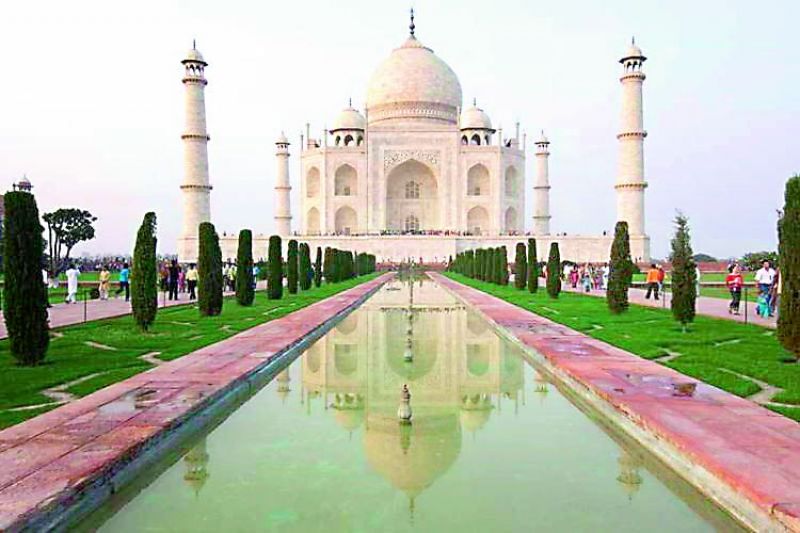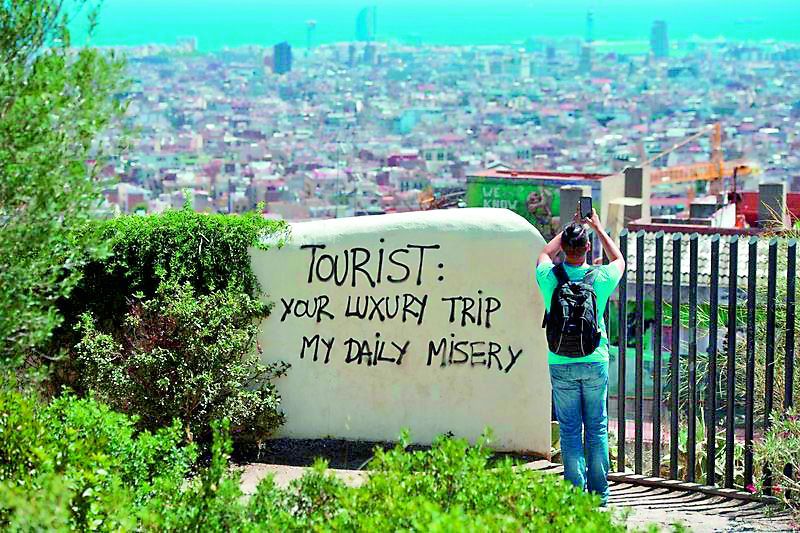Travails of responsibility
Tourism in the global village is a lesson in inclusivity.

Protests, anger and angst, almost as suddenly as the world opened its arms to the itinerant traveller and the orb became a global village, local cries resounded from deep boroughs of old towns, bounced off minarets and towers, and reverberated from church bells, temples and mosques across the world. Be it Barcelona and a stark, “This isn’t tourism, it’s an invasion,” as the expansive warm face of Spain turned livid when a group of masked men slashed tyres of a Barcelona tourist bus uttering slogans like, “Tourism kills neighbourhoods,” to Venice where a limit to tourist numbers in the Floating City is already in place. Croatia has also capped numbers, and cruise ships. Now Paris joins this silent movement to stop home rentals in the city. There is a huge outcry from locals to LEAVE and let live. In India, the Taj Mahal is heaving from the influx of tourists, with its creaking foundation. The outcry across the world is for responsible tourism — and it’s ringing loud, clear and protestfully.
The group behind the bus attack in Spain, Arran, it was reported, said, “Our action is not an attack on tourists, but on those people that profit from the touristic model, accelerating and worsening negative consequences to our city.” Venice has already seen its population deplete to 50,000 according to Time Magazine and Guardian reports. Infact, Venetians came out on the narrow streets of this land of waterways and gondolas, shouting, “Mi no vado via” or “I’m not leaving” to voice discontent. And their fears of this “Venexodus” are not unfounded. The number of Venetians is approaching 50,000, half the figure of 40 years ago, and less than the number of tourists who flock to the city each day! Amidst these protests were reports of a 71-year-old politician of the Green Party in Norway who mocked the number of cruise ships going past his once idyllic, now voyeristic holiday home with a naked protest. Svein Ingvald Opdal, might have done this for fun, yet there was a deeper helplessness. The need of the hour is to focus on tourism that is sustainable and responsible to locals, first and foremost. Or we stand to lose rich legacies and histories.
The Taj Mahal story
We do not have to travel thousands of kilometers to witness this. The abject state of the iconic Taj Mahal is a case in point. Apathy in preserving this beautiful monument which sees 4 million visitors a year, is shocking. A polluted River Yamuna, deforestation and lack of proper conservation, it’s cry for help stands as a precursor for what is to follow if drastic measures are not implemented. From dust enveloping the once pristine marble monument that Shah Jahan built grief-stricken by the death of his wife Mumtaz Mahal, to the cracks appearing on its tombs, and concern over its four minarets tilting, or the green tinge over its marble, India too is in danger of losing an icon synonymous with world heritage.
The government has finally capped number of local visitors to the Taj Mahal, with reports that no more than 40,000 Indian residents will be allowed. Yet, there are reports of night tours opening up now.
 Taj Mahal
Taj Mahal
On the sunny sands of the Arabian Sea lies another gem of Indian tourism, Goa, which is choked under garbage and influx of tourism. Savio Messias, President Travel and Tourism Association of Goa has seen this abject lack of responsibility at close quarters, “We have not taken any measures for responsible tourism. The words are a farfetched dream for Goa, and India. Talks about not wanting over crowding, garbage, unstructured construction have been going on for ages, but nothing has happened. There is no will by the government to get proper legislations and rules in place. We ourselves are allowing uncontrolled growth in every area, be it shacks, resorts, taxis, etc. Even in Simla, there are reports of hotels coming up on hill sides. We need long term measures and legislation but no one is interested.” Responsible tourism is a pipe’s dream in a state where CRZ rules are flouted daily. Tourists come in hoards, stay in buses on road sides, do their abulitions on streets, dirty beaches and litter the beautiful sunny state.
“We see people defecating, dirtying beaches, and the garbage left behind is shocking,” says a resident from Calangute. Messais adds, “You can build any illegal structure and get away with it. There is no enforcement, and the government does not do anything.” It’s now, or never. A need to change the way we view and do tourism. A clarion call for tourism to address, sustain and create a positive environment is getting some countries to address this head on. For if we were to sit idle, many landmarks in the history of our times will be just that — HISTORY. The UNWTO has laid down a code of ethics on responsible tourism. It speaks of Responsible Tourism entailing “making better places for people to live in, and better places for people to visit.” In effect, the ground reality is hugely different.
Elena Manrique, a journalist and Barcelona resident who loves to travel, cautions, The recent protests were inevitable, she feels, “First of all, as a person who loves to travel, I’m not against tourism (‘good tourism’). But there are so many instances that are very intrusive.” The revenue from tourism alone is mammoth. Hassan Madah, director, Israel Ministry of Tourism — India and Philippines focuses on the importance of tourism in the economy, “Travel and Tourism is a crucial industry for many countries, contributing nearly US $7.9 trillion to the global economy in 2017. Revenue from tourism is huge, and a balance needs to be maintained to ensure that we preserve the rich legacies.”

With deeper pockets and the world an oyster, how can the sanctity of locals and the aspirations of a tourist be answered? Dr Jigna Desai, associate professor, program chair for masters in conservation and regeneration, Faculty of Architecture, CEPT University, Ahmedabad delves deep into the problem, “What happens in a household where you keep having guests, and are not able to cater to their needs as you don’t have the resources? The hosts find a polite way of refusing guests. In other cases, family members protest, or the access to people using the resources becomes so uncomfortable and embarrassing that guests stop visiting. Cities are more complex. And heritage sites even more so as such places are not under anyone’s legal ownership. But if you look at the patterns, they are very similar. We see countries like Bhutan limiting visitor numbers by capping visas. Even in Venice and other parts of Europe people are protesting. The discomfort caused by accessing pressure of resources has led to residents leaving a city. It is the last scenario that is most dangerous. We need policies and legislation that pre-empt the scenario and respond to it.”
Israel has started this process by addressing the Dead Sea’s shrinking. In an effort to protect, Hassan Madah, director, Israel Ministry of Tourism - India and Philippines, elucidates, “In May 2018, the Israel government confirmed an investment of 417 million Shekel for a project until 2022, to protect the Dead Sea from shrinking. It is fascinating to imagine how many important people from the past were in that same spot I walked. Watching a Flamenco performance in a gyspy-owned restaurant in Spain, or listening to an accordion on a foggy evening next to Notre Dame or drinking good Bordeaux at a Bistrot table, or watching a masked play at Venice from La Commedia Dell’arte, I can go on forever. I believe each of us has a responsibility of keeping these places magical, and bestow maximun respect so that generations to come can experience their magic too. We cannot expect everyone to understand what it means to respect a place and its heritage but we should all be responsible in preserving it for the next generations.”
The traveller’s conundrum
Recently, there were reports of Utarakhand banning night trekking due it its effect on the local Bugyal tribe and its meadows. The Uttarakhand High Court ordered the state government to limit numbers too. Such caps, be it in Uttarakhand or Venice or Croatia are slowly being put into place. Yet, they also adversely affect the economy and its people. These checks and balances protect the sanctity of a place… be it in the serene environs of Himalayas or the Piazza San Marco in Venice. Will they aid responsible tourism? “Being responsible is necessary to preserve such beauty. Information should be given on all touristic web sites and agencies on respecting and preserving these beautiful unique sites. I have often seen young people drunk, abusing sites by dumping litter in rivers and historical fountains. Videos or information should be distributed, explaining right and wrong. We need to make people aware, that it’s not okay to vandalise, as these places belong to mankind to enjoy for generations to come,” says an emphatic Vito.
Sensitising the traveller on a country’s culture and people apart, the most important tool, Consul-General Dana Kursh stresses is, “Education; It is our responsibility to educate ourselves and the next generation to take care of our land, nature and heritage sites. I do hope my six-year-old son will be able to tour, learn and absorb the heritage of both our nations, revisiting India, or back home in his birthplace Jerusalem.”
 New York’s efforts in sustainability are an example for others to follow.
New York’s efforts in sustainability are an example for others to follow.
A difficult task to balance?
The sheer angst of a local is palatable in the protests, marches and cries. Garbage, vandalism, disrespect, drinking and making a nuisance — Since when was being on a holiday synonymous with leaving all your manners and graciousness behind? Since when was visiting historical sites, and opening your mind to the world through travel such a travesty? It would be now. Doctor Jigna Desai, professor at CEPT, corrects us on the word “preserve,” “I would start by offering a correction of ‘preserve locals’. While I believe it is just a slip of terminologies, the idea of preserving living historic sites often tends to offer solutions that freeze and museumise day to day life into specific cultural practices for the benefit of visitors. That itself can be detrimental to continuation of life as is expected in historic sites. Visitation to historic sites is an important aspect of a global cultural exchange, and for mutual trust among cultures. The most important step would be to recognise the task of preservation of monuments and its associated values, which is not linear or a one time task that deals with a static situation. The sites are dynamic entities with complex and living relationships. The measures and rules for each site are derived from the study and analysis of the site itself, keeping the ethics of conservation in mind while upholding rights, issues of equity and social/ economic/environmental justice. For example, the Taj Mahal is situated next to a river and is in a city and thus is a part of an environment, ecological and social system. Any solution to preserve the monument cannot be thought in isolation. Conservation of the environment around it, social and economic development of the city it is in are linked issues. A more systemic approach that includes exploring innovative ideas and design of new relationships are key to any conservation measures.”
The way forward
Dr Jigna Desai elaborates, “There is no one magic policy or guideline that would work for a place or is universal for all places. Many large and small policies, be it policies for infrastructure development, housing, livelihood, mobility, all contribute to the future of a historic site. There are some measures however, such as heritage impact assessment for developmental projects, that may prove to be a good starting point.” Professor Yuval Harari, the author of Homo Sapiens and Home Deus, says in his book, “One of the best ways to do all that (a travel experience) is to break free from our daily routine, leave behind our familiar setting, and go travelling in distant lands, where we can ‘experience’ the culture, the smells, the tastes and the norms. The tourism industry does not sell flight tickets and hotel bedrooms. It sells experiences.” And it is for us to value those experiences, and protect them.
The responsible tourism credo
The Cape Town Declaration recognises that Responsible Tourism takes a variety of forms, it is characterised by travel and tourism which:
Minimises negative economic, environmental and social impacts;
Generates greater economic benefits for local people and enhances the well-being of host communities, improves working conditions and access to the industry;
Involves local people in decisions that affect their lives and life changes;
Makes positive contributions to the conservation of natural and cultural heritage, to the maintenance of the world's diversity;
Provides more enjoyable experiences for tourists through more meaningful connections with local people, and a greater understanding of local cultural, social and environmental issues;
Provide access for people with disabilities and the disadvantaged;
Is culturally sensitive, engenders respect between tourists and hosts, and builds local pride and confidence.
